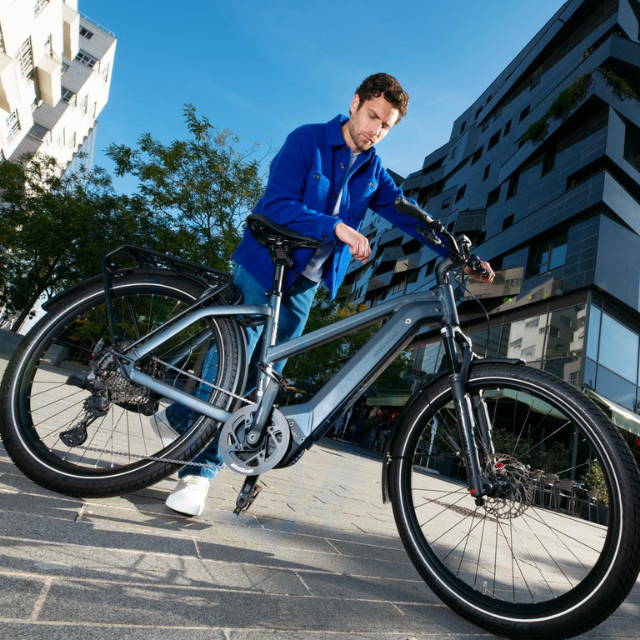Can I Go Bikepacking With an E-Bike?
Written by: Rémy Rossi | April 20, 2025 | Time to read 5 min
Electric bikes help riders move farther and faster, but are they worthy steeds when it comes to bikepacking?

More about the Author: Remy Rossi
Rémy Rossi is a bike writer, mechanic, and educator who got his start in community-based bike shops and co-ops. With a decade in the industry, he still wrenches on bikes when he can and plays bike polo on a fixie.

Cyclists are already “e-bikepacking”, as you might say, but the activity hasn’t taken off en masse quite yet. As an experienced bikepacker myself, I naturally worry about the battery running out on long-distance rides and the challenge of finding a power source to recharge. But those worries may be more fiction than fact depending on your route. As you pull out your portable camp stove, here’s some food for thought when considering if you can go bikepacking with an e-Bike.
Range anxiety: fact or fiction
The average range of an e-Bike is somewhere around 15 to 60 miles, the upper end of which could easily be the distance of a bikepacking day. And premium models or some Gazelle e-Bikes can reach up to 90 miles on a single charge. Of course, additional weight from your bags and cargo as well as hilly terrain will drag down these range numbers.

If you’re bikepacking in the first place, you likely like to cycle and pedal anyway, so you’re probably not just ripping on the throttle or constantly in the highest assistance levels. Staying in or around “eco-mode” and using your own pedal power extends your range and drains the battery less quickly. But if you need more range, you can connect an extra battery or range extender for added mileage— for example, there’s a range extender compatible with some Trek or Specialized e-Bikes and the Giant EnergyPak system.
And if you really need a recharge mid-ride, you can take an extended lunch break and plug in somewhere like a café. However, this isn’t as reliable of a choice depending on where you’re riding. Overall, range anxiety isn’t too bad if your riding days are short and if you are close to power, like between towns or powered campsites.
Recharging when bikepacking
Although you can make it a full day without stopping to recharge, you will have to charge up the battery overnight. Depending on where you’re staying, a hotel or powered campsite can make this easy where there’s good access to outlets. Many campsites in the Netherlands have designated bike corrals and charging stations where you can leave your e-Bike to charge, often with a roof to protect the cables from water. Some parts of Britain and other sites in Europe have these types of e-Bike-specific services for cycle tourists, but I’m unaware of any similar setups in the US.

Keeping your battery charged when wildcamping is a much larger challenge. For bikepackers well off the grid and far from civilization, the lack of recharging opportunities may be an insurmountable roadblock. For more casual trips. e-Bikes could be a good option for quick overnighters out of town or days with stops planned every 30 to 50 miles.
Another recharging consideration revolves around e-Bikes having removable or non-removable batteries. Popular models like the Specialized Vado SL or Specialized Creo 2 have long-range batteries built into the frame and can’t be taken out for off-bike charging. This means you’ll have to leave your bike by the power source, potentially further away from your tent or where you’re staying. That said, the Specialized Creo electric road bike makes a great, high-end e-Bike for bikepacking— I’ve seen reviews where adventurers get nearly 70 miles of range and 93 miles if you include the range extender.
🤝 Why you can trust us for buying an e-Bike?
- Great prices: Get your next e-Bike for up to 60% off retail prices, in new or like-new conditions.
- Quality Guaranteed: Every e-Bike is rigorously certified by a team of professional mechanics, and comes with a 1-year warranty.
- Delivered to Your Door: Delivered to your home within a week. Change your mind? Return it thanks to our 14-day return policy.
Trail restrictions & e-Bike regulations
E-bikepacking: yay or nay?

Bikepacking with an e-Bike isn’t everyone’s cup of tea— normal bikepacking is pretty niche anyway for that matter— but it may even annoy “acoustic” cycle tourists. There’s all sorts of judgments thrown around towards e-Bikers in the traditionally human-powered activity, like e-Bikes are cheating or will disturb the trails more. But I don’t think e-bikepacking is going to replace standard bikepacking anytime soon— to me, they serve different purposes, and largely cater to different audiences.
E-Bikes can encourage recreational riders to join up with more avid cyclists or experienced bikepackers on those longer trips— the pedal assistance levels the playing field without changing much else at all. If you’re already infected with the bikepacking bug, you’re probably not going to switch to an e-Bike all of a sudden, but you may be able to convince a friend to join you. And more people on bikes is something we can all get behind.
Key Takeaways
- E-Bike Range Is Manageable for Moderate Trips: While hardcore bikepackers may outpace an e-Bike’s battery range, most e-Bikes can handle 30–60 mile days with proper usage. Range extenders and strategic charging breaks can help stretch the distance even further.
- Charging Logistics Matter: Access to power overnight—via hotels, powered campsites, or designated bike charging stations—is essential, and wildcamping with an e-Bike is trickier.
- Trail Access & Class Restrictions Vary: E-Bike riders need to check local trail and park regulations since many public lands restrict certain e-Bike classes (especially Class 3). Doing research ahead of time can prevent access issues on your route.


